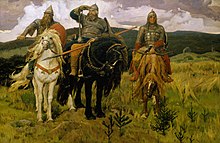Bogatyr

Bogatyr ( Russian богатырь) is the name for warriors from medieval Russian sagas , who are sung about in various heroic songs ( bylins ).
Word origin
The word Bogatyr comes from Altaic and goes back to the historical Turkic-Mongolian honorary name Baghatur ( Mongolian : ᠪᠠᠭᠠᠲᠦᠷ Baghatur / Ba'atur (Khalkha Mongolian: Баатар), Turkish : Batur, Tatar and Kazakh : Батыр Batyr). The original meaning of the word was "hero" or "brave warrior".
This term was introduced into many non-Turkish languages by the Turkic-Mongolian conquests in the 13th century and exists today in different variants such as B. in Bulgarian Багатур (Bagatur) , Russian Богатырь (Bogatyr) , Georgian Bagatur , Persian and North Indian Bahadur , Hungarian Bátor and Polish Bohater .
It must also be noted that the term can be derived from a combination of the Russian word for god Bog ( бог ) and the Nordic / Germanic god of war Tyr , as Germanic and Slavic mythology has parallels and Germanic gods appear in Russian usage. An example of this is Odin , who also represents the number one ( Russian один ). From this composition Bogatyr would mean "from the god Tyr", which would also indicate "hero" or "brave warrior".
Historical background
In real life, the Bogatyri were mostly free mercenaries who, thanks to their training and bravery, gained recognition as Bogatyrs. They were responsible for guarding the borders, training and managing the armed forces of a Knjaz (prince). These soldiers are known through the legends and fairy tales from the time of the Kievan Rus before the Mongol conquest. Especially at the time of the Kievan Rus and the struggle of Russian principalities with the nomads from Central Asia and Finno-Ugrians from the Western Urals, many legends arose about the Bogatyri. They act there as protectors of the rulers and borders of the old Russian cities and even played an important role in the succession conflicts of the Kievan Rus. Some hired themselves as mercenaries and caravan guards and, according to legends and traditions, even traveled as far as India. Dobrynja Nikititsch in particular was known for having fought as a mercenary, presumably for the Kyptschaks or Seljuks in what is now Pakistan and northern India, making a large fortune in the process. It is assumed that the three mercenaries in the painting - Ilya Muromets, Dobrynja Nikititsch and Aljosha (Alexej) Popovich - really existed, although there are very few written sources about them.
Historically, it is believed that the Bogatyri as mercenaries by the Russified Vikings ( Varangians descended) and had the same status as chivalrous elite in medieval Europe.
Today "Bogatyr" is a nickname for a very strong warrior in Eastern Europe and in Russian-speaking countries.
Individual evidence
- ↑ Ed. Herbert Franke and others - The Cambridge History of China: Volume 6, Alien Regimes and Border States, 710-1368, p.567
- ↑ C. Fleischer, "Bahador" , in Encyclopaedia Iranica
- ↑ Anton Thormond Blessed: Alkuna: Nordic and North-Slavic mythology: With 13 engravings, a cosmological map and genealogy . Hartmann, 1831.
Web links
- New cartoon about the adventures of Dobrinja Nikititsch (Russian) Dobrinja Nikititsch and Smej Gorinitsch ( Russian : Добрыня Никитич и Змей Горыныч)